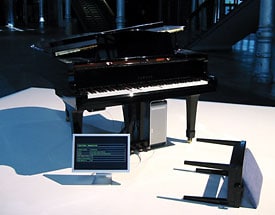Disklavier Technology Breathes Life Into Unprepared Piano
 A library of "found" computer music files is "performed" in the gallery by the Disklavier with the full authority one associates with a concert grand piano. |
Because the Disklavier is instructed to be unaware of what notation is contained in any given "found" MIDI file, and for which instruments the notation was originally intended, it ended up rendering percussion, string and piano parts in unusual and often beautiful configurations and combinations. These directives compelled the Disklavier to play the part of an "Unprepared Piano" with fascinating musical results.
"The piece is marked by an interest in making artworks that appropriate, access or process live data in real time," noted Thomson and Craighead. "It looks at how connections can be made between the virtual space of the internet and physical space."
Originally commissioned for a Paris exhibition in 2004, Unprepared Piano loosely depicts the ideas developed by experimental 20-century artists and composers, such as Henry Cowell, Erik Satie and John Cage, where a piano's timbre was physically altered by placing objects (preparations) between and on the strings, hammers or dampers to create non-traditional tuning and resonance. In effect, Unprepared Piano is both an homage to and an extension of the tradition of John Cage's Prepared Piano pieces, as well as his experiments with the element of chance in his compositions.
"In the case of our Unprepared Piano, the preparation is by means of software a set of rules that characterize the way the piano adapts a rendition of any file it plays," added Thomson and Craighead. "The title is also a joke, referring to the idea of the piano being unprepared for what it is instructed to play, as every performance is generated or improvised on-the-fly."
According to Shilkoff, "The internet has become a vast and fluid cooperative, modified through input by each participant. Ideas including music oftentimes exist online without authorship or context. I think Jon and Alison use technology in a very pensive, lyrical way and present this anonymous and ephemeral material with gravity and insight."
Provided by Frank and Camille's Fine Pianos in Hartsdale, New York, the Yamaha Disklavier DGB1 proved the ideal protagonist for this exhibit because it "pits the generative playback the piece produces against the authority of a traditional acoustic instrument," according to Thomson and Craighead.
"The tone and form of the Disklavier in Unprepared Piano evoke the creative, sensual physicality of composition," added Shilkoff. "Yet the structure of the software subverts our expectation of order and coherence and the 'validity' of performance."
Further information and a video of the work are available at www.thomson-craighead.net.
For more information about Yamaha Pianos, write Yamaha Corporation of America, Piano Division, P.O. Box 6600, Buena Park, CA 90622-6600; email infostation@yamaha.com; or telephone (714) 522-9011.
 |
| © 2010 Yamaha Corporation of America. All rights reserved. |
